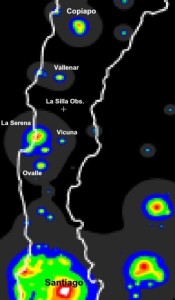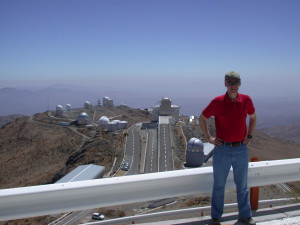Zane Landers presented a talk at the January 2023 HAC meeting about why we should endeavor to support and participate in astronomy outreach events. The talk has been recorded and is available on YouTube.
Category Archives: Guest Speakers
Articles contributed by members and guest speakers
January Guest Speaker: Dr. Everett Schlawin
 The January meeting of the Huachuca Astronomy Club will be held on January 18 at 7 pm in the Student Union building at Cochise College. Our speaker is Dr. Everett Schlawin a Post Doc researcher at the University of Arizona. Everett is interested in what planets and their atmospheres are made of. He studies planet composition by observing transiting planets – planets that cross in front and behind their host stars. Everett is a member of the James Webb Space Telescope NIRCam team, led by Marcia Rieke. The unprecedented Webb telescope will enable giant leaps in our understanding of planet composition.
The January meeting of the Huachuca Astronomy Club will be held on January 18 at 7 pm in the Student Union building at Cochise College. Our speaker is Dr. Everett Schlawin a Post Doc researcher at the University of Arizona. Everett is interested in what planets and their atmospheres are made of. He studies planet composition by observing transiting planets – planets that cross in front and behind their host stars. Everett is a member of the James Webb Space Telescope NIRCam team, led by Marcia Rieke. The unprecedented Webb telescope will enable giant leaps in our understanding of planet composition.
We will take Everett to diner at outback before the meeting. RSVP to Bill Howard (howardwj51 at gmail.com) if you would like to join us for dinner.
Special Event: Dr. Seth Shostak – Monday, November 5th
“SETI: Are We Closer to Finding the Aliens?”
 A talk by Dr. Seth Shostak on Monday November 5, at 7 PM in the Student Union at Cochise College 901 N. Colombo Avenue, Sierra Vista. This community event is sponsored jointly by the University South Foundation (https://www.universitysouthfoundation.com/) and the Huachuca Astronomy Club.
A talk by Dr. Seth Shostak on Monday November 5, at 7 PM in the Student Union at Cochise College 901 N. Colombo Avenue, Sierra Vista. This community event is sponsored jointly by the University South Foundation (https://www.universitysouthfoundation.com/) and the Huachuca Astronomy Club.
Admission is FREE.
For nearly six decades, SETI scientists have searched in vain for a signal from the cosmos that would betray the existence of extraterrestrial intelligence. Does this failure to discover aliens mean something, or could there be something fundamentally flawed with SETI strategy? We consider the state of searching today, and what are the assumptions that undergird the hunt for E.T. And what if a discovery is made? Would the public even be told?
Dr. Seth Shostak directs the search for extraterrestrials at the SETI Institute in California—trying to find evidence of intelligent life in space. He is also committed to getting the public, especially young people, excited about astrobiology and science in general. Seth is the host of “Big Picture Science,” the SETI Institute’s weekly radio show. Big Picture Science can be found in iTunes and other podcast sites.
October Guest Speaker: Dr. Eric Pearce
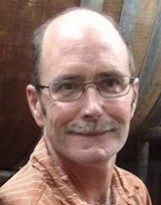 Our next meeting is October 12th at 7PM in the Student Union building on the Cochise College campus. At this meeting, Dr. Eric Pearce will give his presentation on “Space Situational Awareness.” He will discuss how the network of telescopes and radar systems to keep track of the satellites and other manmade objects currently in orbit around the Earth was developed and what purpose it serves.
Our next meeting is October 12th at 7PM in the Student Union building on the Cochise College campus. At this meeting, Dr. Eric Pearce will give his presentation on “Space Situational Awareness.” He will discuss how the network of telescopes and radar systems to keep track of the satellites and other manmade objects currently in orbit around the Earth was developed and what purpose it serves.
Dr. Pearce, who joined the Steward Observatory at the University of Arizona in 2016, has primarily focused his research on the development of advanced systems and astronomical techniques specifically optimized to discover, track and characterize artificial earth-orbiting satellites.
Kartchner Star Party – Saturday, October 13
“Camels in the Sky: Our Heritage of Arabian Star Lore”
Saturday, October 13 at 5:30 in the Discovery Center.
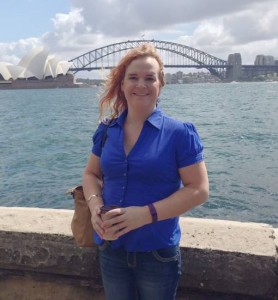 Dr. Danielle Adams, a recent graduate from the School of Middle Eastern and North African Studies at the University of Arizona and NASA Space Grant fellow, will speak about the rich star lore of Arabia as it was more than a thousand years ago. Camels, vultures, goats, wild cows and many other kinds of animals graced the skies of the Arabian desert, and some of these survive in the star names used by astronomers today. Danielle will especially focus on the stars that are visible in the fall so that visitors can find them after the talk in the park’s famously dark sky. Some of these stories can be found on her website, onesky.arizona.edu.
Dr. Danielle Adams, a recent graduate from the School of Middle Eastern and North African Studies at the University of Arizona and NASA Space Grant fellow, will speak about the rich star lore of Arabia as it was more than a thousand years ago. Camels, vultures, goats, wild cows and many other kinds of animals graced the skies of the Arabian desert, and some of these survive in the star names used by astronomers today. Danielle will especially focus on the stars that are visible in the fall so that visitors can find them after the talk in the park’s famously dark sky. Some of these stories can be found on her website, onesky.arizona.edu.
July Guest Speaker: Dr. Kaitlin Kratter
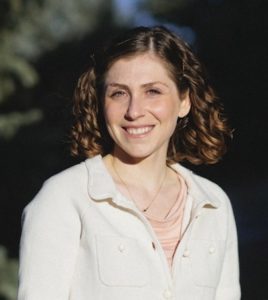 The July meeting will be held in the Student Union building at Cochise College, Sierra Vista on July 13, 2018 at 7 PM.
The July meeting will be held in the Student Union building at Cochise College, Sierra Vista on July 13, 2018 at 7 PM.
Our speaker will be Dr. Kaitlin Kratter, Assistant Professor of Astronomy at the University of Arizona.
Dr. Kratter’s research focuses on the formation and evolution of stellar and planetary systems. Kratter employs analytic and computational techniques to tackle topics including accretion disk dynamics, binary formation, few body dynamics, and planet-disk interactions. Her current work is focused on the intersection of binary and planet formation, especially in circumbinary systems. She is also collaborating closely with observers to discover extreme mass ratio binaries, and very young multiple star systems.
May Guest Speaker: Dr. David Sand
Our May 18th meeting at 7pm in the Student Union, Cochise College Sierra Vista features a talk by Dr. David Sand.
Dr. Sand will give a presentation titled: Gravitational Waves and Things that Go Boom in the Night
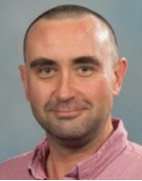 In his presentation, Dr. Sand talks about the ‘time domain’ revolution in astronomy, and how we are finding new ways to study stars that merge, burp and explode by looking at their imprints on space-time via gravitational waves. He will highlight recent results on the gravitational wave detection of the merger of two neutron stars and look to the future of this field. Dr. Sand’s interest in things that go bump in the night led to his team’s search for electromagnetic counterparts to gravitational waves.Continue reading
In his presentation, Dr. Sand talks about the ‘time domain’ revolution in astronomy, and how we are finding new ways to study stars that merge, burp and explode by looking at their imprints on space-time via gravitational waves. He will highlight recent results on the gravitational wave detection of the merger of two neutron stars and look to the future of this field. Dr. Sand’s interest in things that go bump in the night led to his team’s search for electromagnetic counterparts to gravitational waves.Continue reading
April Guest Speaker: Dr. Kevin Hainline
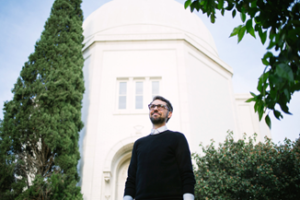 Our April 13th meeting at 7pm in the Student Union, Cochise College Sierra Vista features a talk by Dr. Kevin Hainline.
Our April 13th meeting at 7pm in the Student Union, Cochise College Sierra Vista features a talk by Dr. Kevin Hainline.
Dr. Hainline is an astronomer and researcher on the James Webb Space Telescope NIRCam science team at Steward Observatory at the University of Arizona. His research focuses on hunting for active galaxies and quasars and understanding the effects of a growing, powerful supermassive black hole on its host galaxy. Currently, he is helping to plan the initial deep observations to be done by JWST to explore the evolution of the earliest galaxies. He received his PhD from UCLA in 2012 and spent three years as a researcher and professor at Dartmouth College in New Hampshire, before moving to Tucson to work on JWST. Kevin has a passion for science outreach education, speaking about astronomy any chance he can get. Kevin is very enthusiastic.
March Meeting Guest Speaker: Dr. Nick Ballering
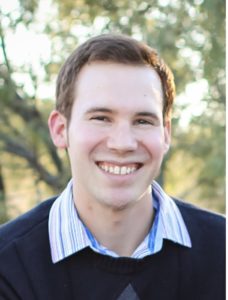 Our March 9 meeting at 7pm in the Student Union, Cochise College Sierra Vista features a talk by Dr. Nick Ballering.
Our March 9 meeting at 7pm in the Student Union, Cochise College Sierra Vista features a talk by Dr. Nick Ballering.
Nick is a postdoctoral research associate in astronomy at the University of Arizona, Steward Observatory. He received his B.S. in astronomy and physics from the University of Wisconsin, Madison. He then attended graduate school at the University of Arizona under the guidance of professor George Rieke, receiving his PhD in 2016. His research interests revolve around exoplanetary systems. What is their architecture? How do they form? How common or rare is our solar system? Nick works to answer these questions by observing circumstellar disks.
The Quest For Darker Skies
Biography
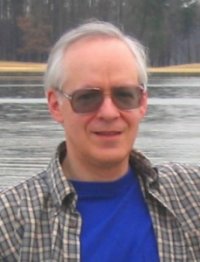 David Butler and his wife Gloria recently moved to Sierra Vista from North Carolina, where he was an active member of the Charlotte astronomy club. David studied Business at the University of North Carolina and later received his MS in Electrical Engineering from North Carolina State University. He spent nearly two decades in research and development in the emerging home automation industry, with an emphasis in energy management systems and advanced utility load control. During this time, he was a featured columnist for Electronic House magazine and later produced a nationally syndicated newspaper column on home technology. In recent years, Butler helped develop a breakthrough diagnostic tool for air conditioning contractors and won a federal grant to develop a low-cost monitoring system for residential air conditioners, partnering with Oak Ridge National Labs. Currently, Butler designs HVAC systems for high performance homes though Energy Star providers nationwide and is in the early stages of planning a small eco-village near Sierra Vista as a demonstration of cost-effective energy and water conservation. Butler belongs to the American Society of Heating, Refrigerating and Air-Conditioning Engineers.
David Butler and his wife Gloria recently moved to Sierra Vista from North Carolina, where he was an active member of the Charlotte astronomy club. David studied Business at the University of North Carolina and later received his MS in Electrical Engineering from North Carolina State University. He spent nearly two decades in research and development in the emerging home automation industry, with an emphasis in energy management systems and advanced utility load control. During this time, he was a featured columnist for Electronic House magazine and later produced a nationally syndicated newspaper column on home technology. In recent years, Butler helped develop a breakthrough diagnostic tool for air conditioning contractors and won a federal grant to develop a low-cost monitoring system for residential air conditioners, partnering with Oak Ridge National Labs. Currently, Butler designs HVAC systems for high performance homes though Energy Star providers nationwide and is in the early stages of planning a small eco-village near Sierra Vista as a demonstration of cost-effective energy and water conservation. Butler belongs to the American Society of Heating, Refrigerating and Air-Conditioning Engineers.
Presentation
At the Friday, January 18, 2008 meeting of the Huachuca Astronomy Club, the guest speaker was club member David Butler. His presentation was entitled, The Quest for Darker Skies. David’s talk related more of the human side of astronomy, rather than the technical aspects of the craft. Because he came from the Southeastern U.S., Dave shared some southern jokes, such as, “You might be a redneck if you thought ‘aperture fever’ was something you got vaccinated against as a kid.” Being from the Southeast region, Dave’s biggest frustration was not being able to observe the deep sky adequately, due to the constant hazy skies and the horrendous light pollution. Dave presented graphics on the problem of global light pollution to make a point about how hard it is to get away from it. The graphics demonstrated how difficult it is to find any dark skies now, especially in any of the highly populated portions of the United States. He mentioned the Google Earth application, which now features a night-view layer that gives a clear, local roadmap-like context to the blight of light pollution.
Dave used to travel to the Blue Ridge Parkway while living on the East Coast trying to find dark skies, and ended up literally on the Road to Nowhere. Dave finally planned an extended road trip to some of the darker areas of the Southwest in his journey to find dark skies. The first night he ended up in Mississippi. Dave checked the Sky Clock along the way, and traveled on to Arkansas, but he was winging it. At one point Dave drove twenty-five miles on dirt roads, running low on gas, until he reached a filling station that was about to close. With a full tank of gas and new directions, he continued on to find an open area where he could do some dark-sky observing. He then continued his quest and drove to Oklahoma, then Texas. While in Oklahoma, a friendly rancher took him to a range in the middle of his ranch to find dark skies. The rancher dropped him off, warned him about the rattlesnakes, and told him that there should not be a problem as long as he stayed out of the bush.
The presentation then described the ultimate fulfillment of his quest- his trip to Northern Chile’s Coquimbo region, with a 5-inch Mak-Star (130mm Intes Mak + NexStar mount), configured especially for the trip. Some regions of the Atacama Desert are so dry that there has been no recorded rainfall in history! Chile is also known for having extremely stable air, so this region sits underneath one of the clearest atmospheres in the world.
Dave’s traveling companions were his wife Gloria, and a small group that included Mark Wagner and Ray Cash. Gloria speaks Spanish, and it turned out to be a valuable skill because few are English-speaking there, as opposed to our closer neighbors such as Mexico. Dave first described some of the major observatories in Chile. The European Southern Observatory (ESO) operates the Very Large Telescope (VLT), located on Cerro Paranal, 2600 meters (8,530 feet) above the Atacama Desert. The VLT is the world’s most advanced optical instrument, consisting of four Unit Telescopes with main mirrors of 8.2 meters in diameter and four movable 1.8-meter diameter Auxiliary Telescopes. The telescopes can work together, in groups of two or three, to form a giant interferometer. The ESO also has plans for a 100-meter optical telescope, the Overwhelmingly Large Telescope (OWL), though this design may get scaled down. Although Dave’s group did not get to visit Paranal due to the distance involved, they did visit the ESO facility at La Silla, located 160 kilometers (99 miles) northeast of La Serena at the southern edge of the Atacama.
David spent the first part of the two-week excursion in La Serena, a four hour drive from his arrival point in Santiago, and then on to Vicua in the Elqui Valley east of La Serena. While in Vicua, he visited the Cerro Tololo Inter-American Observatory (CTIO) and the Southern Astrophysical Research Telescope (SOAR). CTIO is located about 45 minutes southwest of Vicuña, atop Cerro Tololo at 2200 meters (7,216 feet) elevation. The Blanco 4-meter telescope, commissioned in 1974, is a near-twin of the Mayall 4-meter telescope on Kitt Peak. The SOAR facility, located on nearby Cerro Pachón at 2738 meters (8,983 feet) above sea level, features a 4.2-meter optical and near-IR telescope. David was able to arrange a visit to SOAR, which had not yet been commissioned, because of its affiliation with his alma mater, the University of North Carolina, and his prior acquaintance with Dr. Wayne Christiansen.
The Chileans are serious about their astronomy. They recognize the precious resource they have with their dark skies; an idea which more Arizonans should support. There are several municipal observatories available for touring. One of these is the Mamalluca (pronounced “mama-yook”) Municipal Observatory located nine kilometers (five and a half miles) northeast of Vicuña. Mamalluca is an amateur-friendly facility. Collowara (pronounced “coyo-wara”) Observatory in Andocollo is another municipal observatory, owned by the government, and open to the public with a 16-inch Meade Dob and a 12-inch Meade SCT. Collowara means Starland in the Aymara language. David noted that the Elqui Valley region has many attractions, including good fresh food, wine, and the liquor “pisco,” made from grapes, which is the Chilean national drink.
One of the highlights of the trip was their stay at an astronomy-themed inn called La Frontera. This place offers astronomy pads with power. Here they ran into famous astrophotographer Loke Tan, who was also taking advantage of the location’s fantastic clear and dark skies. Although none of the deep-sky observers went all the way to Chile just to see Jupiter, they were all impressed with the view of the giant planet. David characterized the image as picture-postcard perfect.
David said it took a long time to plan for this dream trip. He said the time spent planning the trip was greater than the duration of the trip itself. He proposed the trip through a Yahoo discussion group on the Internet. The Internet site is now a resource for others planning astro-trekking trips to Chile. Since it is a discussion group, you must make a request to join the group, but all with any interest are welcome to join.
If you ever want to visit Chile, March is a good time to go. The high season in that part of the southern hemisphere runs from December through February. March in the northern hemisphere would be equivalent to September down there -the end of summer. So, the time is right. As for the distance, no place is too far to go for astronomers with a passion for dark skies and the celestial majesty they reveal.
Additional Information
Official Chile Trip web site. Discussion group related to astro-treking in Chile Including an extensive collection of astronomy and general travel links related to Chile.
Related webpages
Mark Wagner’s travelogue from 2005 Chile trip.
Ray Cash’s travelogue of 2005 Chile trip.
Ray Cash’s observing notes from 2005 Chile trip.

